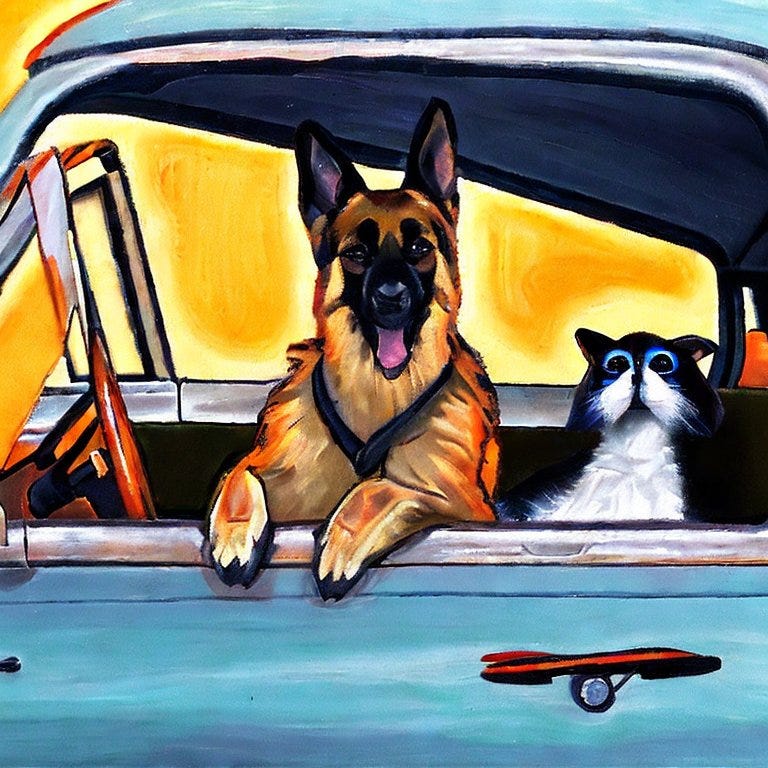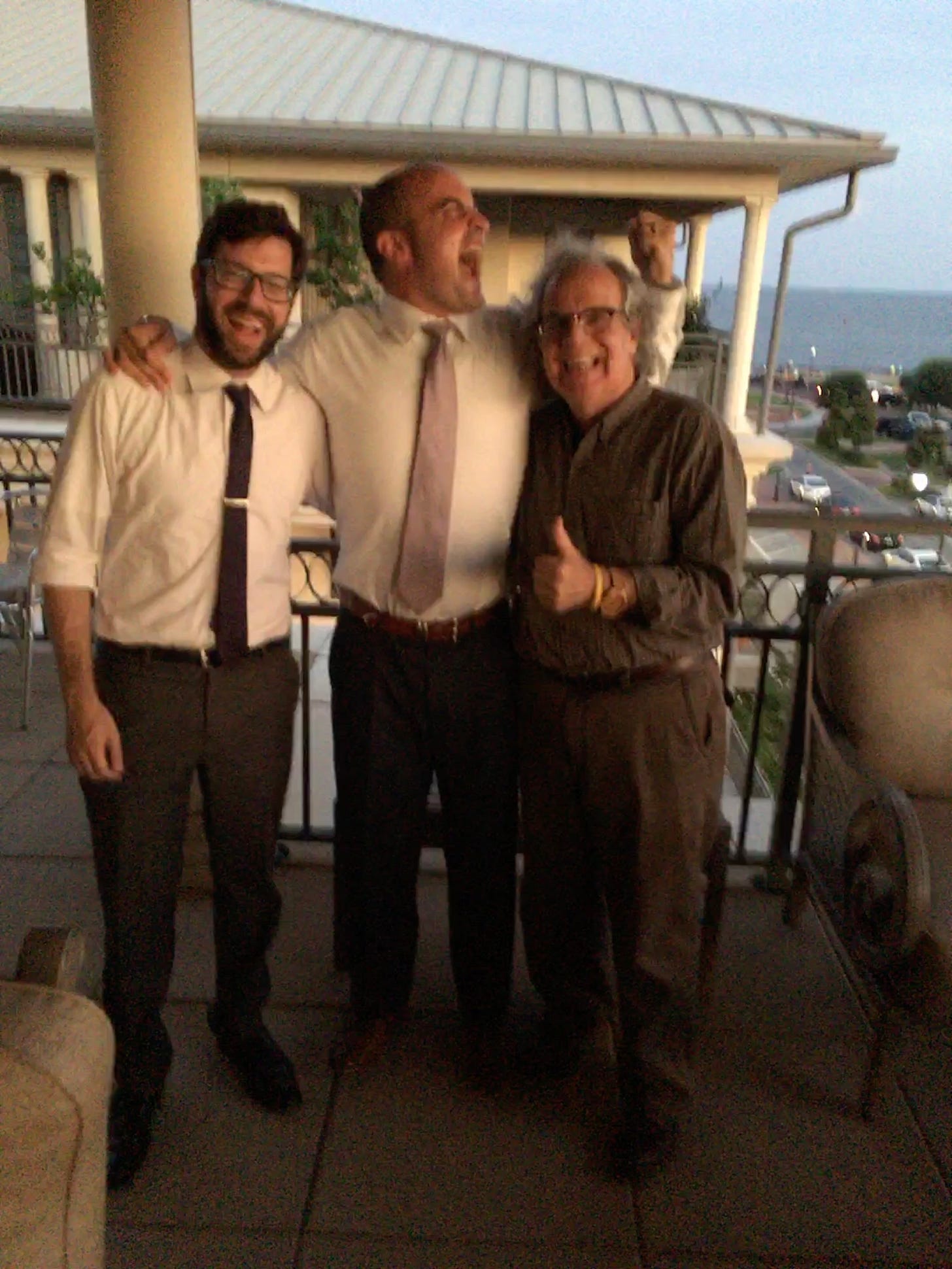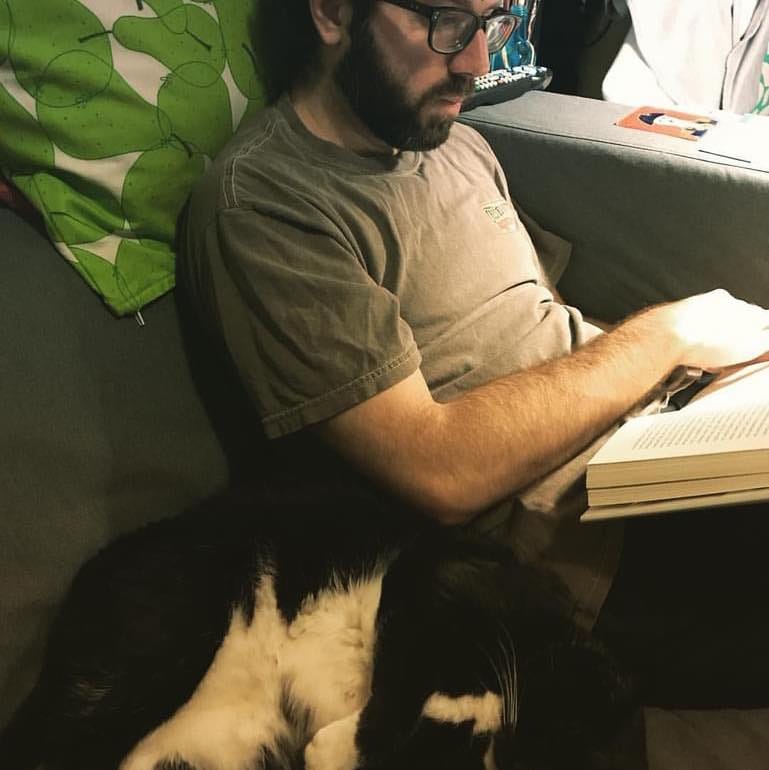Welcome to the Brown Barge! I’m Spencer. This essay is the fourth in a six-part series about my favorite podcast Mystery Show, which solves mysteries that can’t be solved using the internet. In each essay I re-listen to one of the show’s six episodes to find what they reveal about me and the world.
In Part One I explored a disappearing video store, my mom’s mysterious illness, and how our brains turn us all into liars. In Part Two I wrote about how a heartfelt conversation with a Ticketmaster customer service representative, a photo of Britney Spears holding a random book, and my own trip to a karaoke bar show how we’re all interconnected. In Part Three a long-lost belt buckle helped me delve into my dad’s resilience, grapple with different ideas about fate, and see how tiny changes can ripple into our lives.
Mystery Show’s fourth episode, Vanity Plate, is all about love and how we express it. You don’t need to listen to the podcast or read any of the previous essays to enjoy this one.
All you need to do is to ask yourself: Do you say I love you?
I love you, brother
There are some people who say I love you all the time. My good friend James is one of these people. At first glance you wouldn’t guess that James and I would be friends. James is extremely extroverted and gregarious; I am naturally introverted and a bit guarded. James is a risk-taker, fueled by adrenaline and constantly taking action; I am risk-averse, fueled by contemplation and constantly analyzing situations. James and I bonded in large part because, although we’re quite different, we don’t bullshit and we are fundamentally service-oriented.1
James throws around “I love you” with abandon. But instead of being trite, these expressions always hit home for me because it is obvious that James really means what he says. James fiercely loves his family and friends, but he also extends that love out more broadly and backs his words up with actions.
In 2016, I quit my job in Washington, D.C. and moved back to my hometown in the Florida panhandle. James and I worked together, lived together, and spent many late nights trying to solve the world’s problems over glasses of whiskey.2 During one conversation, James said something like: “you know your dad is great; you should tell him you love him more.” And in that moment it hit me that I’d never really told my dad that I loved him.
James helped me see a blind spot, and in the six years since James and I had that conversation, I’ve told my dad I loved him more than I had in the previous 30 years of my life. But it wasn’t until I re-listened to Mystery Show’s fourth episode that I realized that I had actually been expressing love to my dad all along, just not through words.
Red light time vortex
Starlee Kine is both the client and detective for Mystery Show’s fourth case, Vanity Plate. While running errands together, Starlee and her friend Miranda3 get stuck at an impossibly long red light. In an attempt to distract themselves from this red light time vortex, Starlee and Miranda start to examine the other cars around them when suddenly:
We saw a license plate that said “ILUV911”…The plate was attached to an old Buick wagon, half beige, half a sort of orangey tan, colors that cars don't come in anymore. We couldn’t stop talking about it. We would try and move onto a new topic of discussion but we kept just coming back to that plate.
There are two layers to this mystery. First, the surface level: who gets this license plate and what is it that they love? It can’t be a terrorist. As Starlee points out, “the last thing a terrorist would do is get a license plate that said: I’m a terrorist.” The podcast explores other theories—perhaps the driver is an enthusiastic 911 operator, maybe they’re a super fan of the San Diego radio station 91x, or they just really love Psalms 9:11?
But dig beneath the surface and there is a more interesting mystery. What is the license plate owner trying to tell the world? Starlee and Miranda agree that there is a deeper message:
We had the distinct impression that the driver was trying to communicate something powerful to us…The person would have had so many opportunities to reconsider and yet they powered through, determined to declare their love to a world that couldn’t possibly relate. We didn’t know if we’d ever understand that love but we felt a need to at least decipher it.
This is the real mystery, because at its root is a question that has baffled humans for as long as we’ve been around: how do we tell someone that we love them?
How I learned to say I love you
Each episode of Mystery Show is an expression of love. Our host is taking her time to bring peace of mind to other humans in the world and brighten the lives of strangers in the process. I connect so strongly with Mystery Show because I learned to express love in a creative way from my dad.
Last week, I wrote about my dad. His name is Ross and he is one of the most loving people that I know. The clearest way to illustrate how my dad communicates his love is by talking about his music. My dad has been a musician since he was a kid and a professional songwriter for most of my life. In 2018 my dad decided to spend some of his time writing, singing, playing, and producing songs for a non-profit called Songs of Love. Songs of Love was created in 1996 to bring free, personalized, original songs for kids going through medical, physical, or emotional challenges. Over the years, Songs of Love has brought joy into the lives of 40,000 kids and their families. In the last five and a half years, my dad has written almost 550 of these Songs of Love—each one personalized.
I’ve been working remotely over the past three years and have spent about a quarter of that time back home helping out my parents. During these extended stays, I’ve had the chance to work with my dad on a number of his Songs of Love, including one particularly moving song.
About a year ago my best friend’s baby niece was hospitalized. I had met her niece a few months before and when I heard the news my first thought was “my dad and I have to do a Song of Love for her.” Working on that song was my way to bring a bit of comfort to people that are important to me and to simultaneously say I love you to my dad and my best friend. I expressed love in the way that I knew how—by creating.
Listening to the Vanity Plate mystery I wondered, who was the license plate owner saying I love you to?
Gumshoe and the Driving Dog
To solve the mystery, Starlee pairs classic detective methods with idiosyncratic wild goose chases. On the classic detective front, Starlee gets a cop to run the vanity license plate, cross references utility bills and wedding records, and ends up with an address for the license plate owner.
Mystery solved? Almost.
But first let's take a detour down the idiosyncratic goose chases because one of them includes a story that seems too strange to be real. If you’re like me the most obvious explanation for the license plate is that 911 refers to the emergency services number, not the date of the terrorist attack. To try and figure out whether the license plate owner could be a 911 operator, Starlee gets on the phone with a woman named Carol. Carol was one of the first 911 operators in the country, and she tells Starlee that in the early days of 911, people hadn’t quite figured out exactly how to use the service. Case in point:
Carol: There was one situation I just picked up the phone and this person said there’s a German Shepherd dog driving the car. He gave me the description of the car and the location...And within two or three minutes, an officer comes on the air and says "yeah, you’re right, I’m sitting behind this car and there’s a dog sitting in the driver's seat, and he had his paws up on the steering wheel and he is aiming the car”…So he pulls it over and the guy had taught the dog how to steer and he was sitting in the passenger seat, working the foot pedals, the brake and the gas. And apparently the dog did pretty good, as far as steering.
Starlee: I have a lot of questions. If you teach your dog how to drive, is that illegal?
Carol: Well we joked around about who was going to get the ticket, but the guy got the ticket. We cited him for allowing an unlicensed driver to drive the vehicle.
Starlee: Wait a minute! If the dog got a license would it then be legal?
Carol: Probably.
This driving dog story made me think of James, who is probably going to stop reading this and immediately go teach his 120-pound Bullmastiff Chico to drive.
So back to the mystery. With an address in hand, Starlee hops in the car for a stakeout with her friend Matt, whose “main stakeout partner qualifications are that his schedule is flexible and that he is prone to grumbling.”
They pull up to the house. At first neither of them see the car, but then, as they turn into the driveway, they see the nose of a car poking out with the license plate “ILUV911.” By this time it is late and Starlee decides to come back to the house early the next day.
When she arrives in the morning, Starlee knocks on the door tentatively. No one answers on the first knock, but then someone shifts the curtain and responds. Mystery solved? Not quite. Turns out the owner of the license plate lives in the house just behind this one. Her name is Margaret.
So, now Starlee has a name, Margaret, and only a few more feet to walk to find her answer. But when Starlee knocks on the house out back it turns out that no one is home. Starlee is a determined detective, so she comes back a third time the following day bearing a gift of flowers.
Starlee knocks again. No response. But finally a faint voice answers. Starlee explains who she is and why she’s at the door. The faint voice tells Starlee that she can’t come to the door. Starlee tries to pin her down on a time to come back, but eventually she just leaves the flowers.
Being so close and failing to solve the mystery leaves Starlee feeling “like instead of two doors separating us, there's a hundred.” Starlee gets back into her car and starts to drive home, but she is so dazed that she keeps missing her turns. Until she gets a call on her cell.
"Sweetheart." It’s Margaret. "I only have a few minutes but I wanted to tell you the story behind my plate. Also, thank you for the flowers. They’re beautiful."
In the course of this phone call, Margaret unravels the mystery. I’ll let Starlee tell it:
In 2001, Margaret was living in New York. Her mother was living in Los Angeles. That year, Margaret had a feeling. She doesn’t know how else to put it. No one ever believes her about it, she says, but that's ok. She had a feeling she needed to go to LA for her mother's birthday, so she booked a flight. Her mother's birthday was September 11th. Because she went to see her mother, Margaret wasn't in New York on the day of the attacks. She believes that her life was saved by doing that, saved by her mother's love. She got the license plate shortly after 9/11 to honor her mother’s birthday and also to commemorate the victims who died.
So we have our surface level mystery solved. “ILUV911” is an expression of daughterly love, of the decisions in life that take us from one course to another, of grief and mourning for lost friends—it is one of the many ways that we try to show to the world how much we love something and how hard it is to convey that love.
But what about our deeper mystery about how we communicate love?
After filling Miranda in on Margaret and her story, Starlee asks Miranda if she thinks the mystery has been solved. Here’s Miranda’s response:
Deeply. Profoundly. We were right, there was something up with that plate…More and more, I believe there is no accuracy in communication. There are only mistakes. It is so hard to communicate love, or sadness combined with love. That's a very complex thing. And that's what brings us grace, it's not accuracy. And she trusted that when she made the plate, that somehow the most confusing, contrary message in the world would speak to people's hearts because her intentions behind it were so clear and so strong, that it was effective. All the things that made our heart beat turned out to be relevant, and I feel like we got her message.
With both layers of the mystery solved, I only had one more question to explore: was I also saying I love you in strange and indecipherable ways?
When love is spelled D-U-E-G
June 14th is the day that Mystery Show’s fourth episode, Vanity Plate, was released. It is also the day that, two years ago, my cat Eleanor died. Eleanor was a resplendent tuxedo cat, photogenic and weird in all the best ways. My partner Heather Marie and I adopted Eleanor in February 2017, when a neighbor found her meowing outside their door. It turns out that someone had moved out hastily and abandoned Eleanor.
I didn’t really want a cat, but Eleanor and I bonded immediately. She wasn’t a lap cat, but she would snuggle next to my leg and sleep against me as I sat on the couch. For a period of time she slept above my head on my pillow, in a maneuver we called the Cat Hat. Eleanor had many funny behaviors, but her most persistent one was what we called donking. If she wanted pets or food or attention she would come up, donk her head insistently against your leg, and then look up expectantly. And so I started calling her Donk.
As my bond and affection for Eleanor grew, I communicated my love by morphing this nickname in increasingly nonsensical ways. Donk became Donkeroo.4 Then Donkeroo shifted to Donkerdew.5 After many other senseless (yet meaningful) iterations, Donk became Gradueg6 or simply Dueg. I don’t know why I settled there, but Dueg was what stuck.
A few months before Eleanor died my partner Heather Marie ordered us two custom mugs. One said Donk with an angelic photo of Eleanor. The other said Gradueg with a photo of her sitting in a funny way that looks like she’s saluting the King of Tuna. I expressed my love for Eleanor through a series of increasingly absurd nicknames. Heather Marie expressed her love for me through these gifts. I cried tears of happiness when she gave me the mugs; I cried tears of sadness when Eleanor died unexpectedly two years ago today.


It seems impossible for me to describe how much love I had for Eleanor, and if it is impossible to describe how much love I had for a pet, then how could I possibly describe how much love I have for the most important people in my life?
I can create.
And so here I am on Substack saying:
I love you.
I’m using bullshit here in the way it is defined by the philosopher Harry Frankfurt, meaning to try to persuade without regard to the truth. James and I shoot the shit all the time, but we are both pretty wired to seek the truth and act accordingly.
Thanks for not killing us, Katie.
Incidentally, the Miranda here is the author and filmmaker Miranda July.
I grew up in the 90s and ate a lot of Dunkeroos.
I grew up in the 90s but did not drink a lot of Mountain Dew.
Pronounced Gruh-doog.








Another enjoyable , well written, and interesting piece, Spencer. Eleanor surely knew, and could feel, how much you and HM loved her. She basked in that love! I’ve witnessed many examples of your language of love, especially toward Heather Marie. Carefully chosen gifts, supporting and joining in on her love of Improv, your tenderness toward her. I’m happy to be connected to you, and I am saying, I love you!
In Spanish, we have the casual "te quiero," which can be translated as I like you and the loaded "te amo." I very seldom use the latter. However, in English is very easy to say things like "I love pizza," when in reality, I may only like pizza a lot. I find those kind of quirks of language fascinating.
I think that between men, it can be challenging to show affection for one of our brothers. I have a few men in my life who wouldn't flinch if I told them I love them. I also come from a very touchy-feely culture, so we use that instead of words to communicate affection.
My wife says that my love language is acts of service since I enjoy making her life easier by helping her do some of the tasks she dislikes. But obviously, verbalizing my love for her is important.